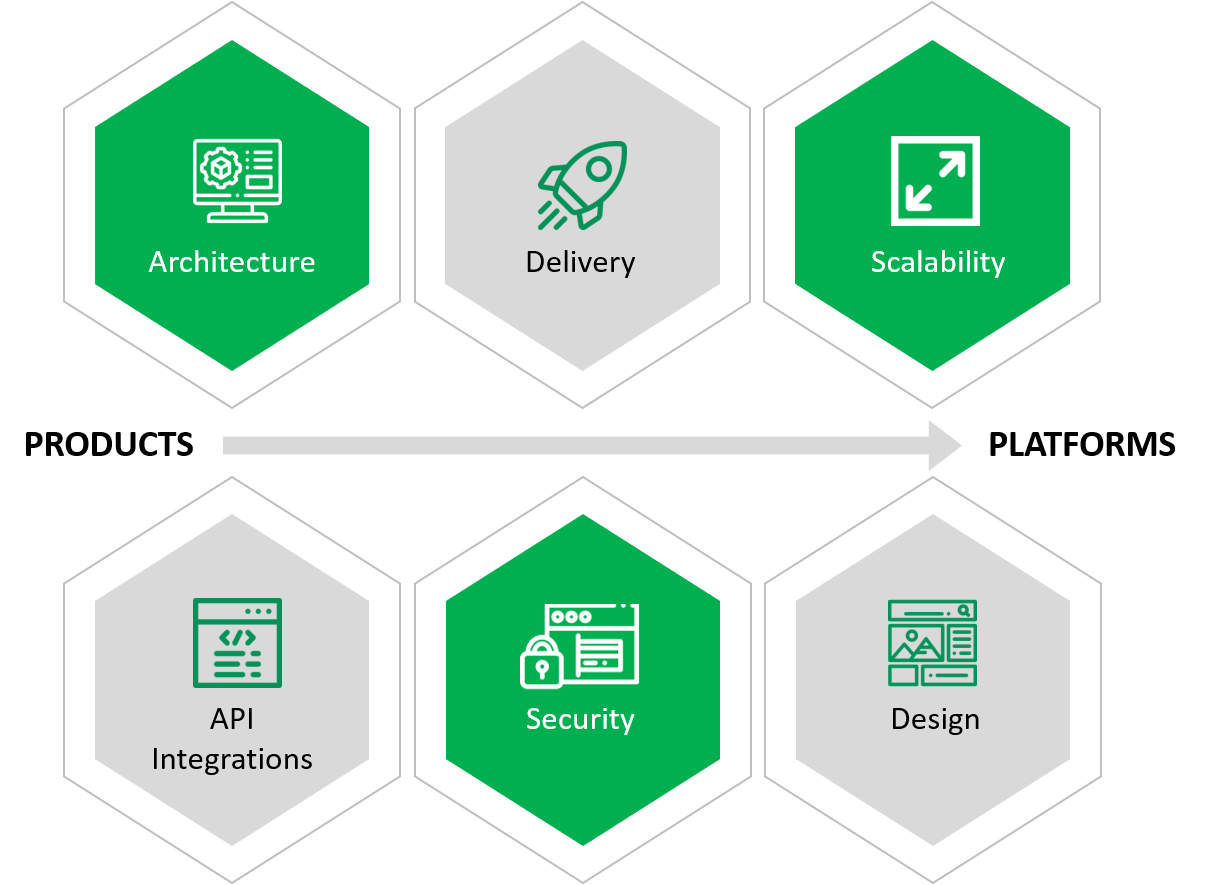



Some of the world’s most valuable public companies are built on digital platforms. These include companies like Amazon, Facebook, and Google. In 2017, when MIT Sloan conducted a study on 200 unicorns, it found out that 60% to 70% of them were platform businesses1. So, what’s unique about platform-based businesses? How are they able to grow and thrive in this hyper-competitive environment? The answer lies in their ability to offer unique value by building an entire ecosystem that enterprises can leverage to serve their users. In a sense, the platform becomes a key enabler of business outcomes, thus making it more essential and irreplaceable.
So, Amazon is no more an e-commerce website, it is a platform where third-party sellers can sell everything – from apparel to machine tools. It has become a key enabler of digital commerce strategies for all manner of businesses.
Facebook is not just a social media website. It is a platform that provides APIs and tools to third-party developers to build their own apps that interact with Facebook’s core features for everything from marketing and advertising to support. It has become a key enabler of communications and discovery between businesses of all sizes and their target audiences.
In the enterprise context also, CRM solutions are assuming the role of key enabling platforms as are ITSM solutions and a host of others too. Typically, ISVs used to build products that supported a particular vertical or domain or a narrow function within a domain. They created products with a contained feature set and offered on-premise licenses that were expensive and had minimal scope for customization.
Now with the rise of the platform-based business model, ISVs are looking beyond just building products. Their work is not limited to building for a specific domain or sub-function. They are building a complete ecosystem that supports marketplaces, integration points, and multiple capabilities. Thus, providing their enterprise customers with a competitive advantage and scope for opening a new revenue stream.
However, a shift from product to platform building comes with challenges. The ISVs face implementation challenges such as choosing the architecture while developing multiple services to support the dynamic business needs. Enterprises, on the other hand, face an adaptation challenge, which includes changes in operational needs, technological requirements, and limitations in functions.
To ensure smooth implementation and seamless adaptation of platform services, product owners and VPs of Engineering will have to focus on the following components.
Things To Consider When Products Becomes Platforms

1. Architecture
When it comes to developing platforms, the engineers are clear about their choice. They choose microservices architecture over monolithic architecture to build platforms as it operates as modular components that perform individual functions. It can split applications into separate services that function independently without impacting the functions of other applications. This allows new functions (like integrations) to be rolled out faster without impacting other facets.
Also, considering that platforms are built as API-first i.e. use APIs to interconnect multiple applications and exchange data seamlessly, microservices architecture is the obvious choice for engineers. This also leads to engineers choosing cloud capabilities over on-premise to manage the platform efficiently.
2. Scalability
Given the scalability challenges, ISV engineers are always looking to address situations where the number of users increases. In the case of platforms, the engineers would also be worried about the increased load due to the addition of new applications to the platforms. The good news is they no longer have to worry about scalability. Platforms are based on APIs that interconnect multiple applications and allows seamless data exchange between them seamlessly.
So, ISVs don’t have to scale the whole platform. They can just focus on the applications that need to be scaled without impacting the performance of other applications. However, to be prepared for any unexpected circumstances, ISVs may consider using a Service-Oriented Architecture (SOA) to ensure that the platform and all the applications within the platform are easily scalable and manageable2. They must ensure that the platform can meet the increasingly diversified demands of the users.
3. Delivery
The goal of a platform is to deliver rich experiences and value to its end-users. Considering that a platform has largely distributed applications, ISV engineers must ensure a seamless delivery. The objective is to ensure that the performance of one application does not impact the others. That’s where development approaches such as DevOps may help.
DevOps can help ensure that the continuous evolution of the platform is addressed consciously. Continuous testing, integration, and deployment help drive platform evolution. Using DevOps’ concepts encourages continuous innovation, improves productivity, and decreases time-to-market. DevOps helps in accelerating the delivery process as engineers build the platforms.
4. API Integrations
ISV engineers building platforms have to think from an API-first perspective and address the nuances that come with every choice. For instance, developers have to decide if the API should be kept private or be exposed to the public, i.e. shared with third-party developers.
If the engineers decide to make the APIs public, they must pay attention to security and comply with privacy policies. One way to solve this dilemma is by introducing the APIs as private APIs, testing them fully, and releasing them to selected partners in the ecosystem. If no security loopholes are found, the ISV engineer and the company can make it publicly available.
5. Security
Engineers must pay attention to platform security to instill trust among end-users, not an easy task considering that other apps would be residing on the platform as well. They must secure the entire platform with the help of centralized security architecture. This enables them to eliminate the need for individual security measures for each layer and system within the environment as that can become complex later.
Some security solutions that can be considered to protect the platforms include – DevSecOps, compliance-as-a-service, and scalable threat response. The objective is to take pre-emptive measures to mitigate security risks, build and maintain a platform that adheres to compliance regulations, and ensures a long-lasting and trustworthy relationship with end-users.
6. Design
To encourage end-users to use platforms, ISVs must design user-friendly platforms. The designers have to adopt platform thinking3, which means that they need to think beyond designing a new product or feature. UX designers should focus more on improving the entire platform's user experience. They must also pay attention to interaction design principles because most platforms are built with omnichannel capabilities.
So, the navigation patterns should be consistent across various devices and screen sizes. They must shift their focus from designing just pages and screens to designing for an entire platform. This means that they must ensure that the designs of their applications and that of the third-party apps are unified and aligned with the company’s expectations. To do that, they must craft apt guidelines for all the apps to adopt.
Conclusion
The digital customer’s expectations have increased. They demand great experiences and extreme function from companies. ISVs should take this opportunity to become an irreplaceable part of the technology ecosystem. This will enable them to become more innovative, expand their capabilities and offerings beyond products and services, and increase their revenue. By engaging with the right technology experts, ISVs can build great platforms and innovate continuously to help companies achieve profitability and growth.
References
1. The Future of Platforms
2. The Need for Scalability in Platform Architecture
3. Platform Thinking






 View Previous Blog
View Previous Blog




